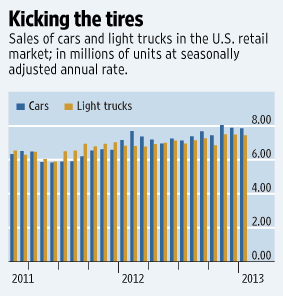Discussions of how to make vehicles more energy efficient often focus on nifty new technology: the latest hybrid twist, or the coolest new electric vehicle. But much of the recent gain in fuel economy seems to be coming from something much more mundane: cars are becoming more popular than SUVs and pickups.

The chart to the right—from the Wall Street Journal‘s website—may not be the clearest, but it shows that sales of passenger cars (the blue bars) inched ahead of SUVs, pickups, and minivans (the orange bars) during most of 2012.
You may recall that this happened once before. The 2008 double whammy—recession plus spiking gas prices—sent all vehicle sales tumbling; but light truck sales fell particularly quickly, meaning that cars edged out SUVs, minivans, and pickups in both 2008 and 2009. Yet after gas prices dropped and the economy came out of freefall in 2010 and 2011, light trucks once again outsold cars—which made last year’s resurgence of the passenger car come as a pleasant surprise.
Historically, the shifts in car vs. truck sales have had a big influence on vehicle efficiency. Look, for example, at the estimates of new vehicle fuel economy published by the University of Michigan’s Transportation Research Institute.
The fuel economy of new vehicles grew quite nicely in 2008 and 2009 (when car sales outpaced truck sales), flattened out in 2010 (when truck sales inched ahead again), and rose rapidly again in 2012 (when car sales once again surged ahead of trucks). Improvements in vehicle technology may have kept vehicle efficiency from backsliding as truck sales pulled ahead of cars. But the data clearly suggests that the biggest efficiency gains came in the years when cars outsold trucks.
Unfortunately, the Northwest isn’t much of a leader on the cars-vs-trucks front. Washington does fairly well: according to the most recent data from the National Automobile Dealers Association (yes, Spanish-speakers, their acronym is NADA), passenger cars represent about 56 percent of the light-duty vehicles registered in the state, compared with 53 percent for the nation overall—meaning that Washington ranks 13th among the 50 states for the mix of cars vs. trucks. That’s not terrible, but it lags well behind the leaders: Connecticut, New York, Rhode Island, and (perhaps surprisingly) Virginia. Meanwhile, Oregon ranks 29th, according to NADA data, and Idaho an abysmal 47th, trailing only Alaska, Montana, and Wyoming. And combining the three Northwest states, the Northwest is actually a little more truck-heavy than the nation as a whole.
There’s an interesting wrinkle in all of this: it’s likely that new federal fuel economy standards may create some strange incentives for manufacturers to boost truck sales. The new CAFE standards actually set different fuel economy standards for each manufacturer, based on the actual mix of cars and trucks they sell—so companies that sell lots of trucks face lower standards than those who sell lots of cars. Conversely, companies that sell lots of super-efficient cars, particularly all-electric models, get some wiggle room to sell more big (and typically profitable) SUVs and pickups. All of which is to say: it’s likely that federal standards, as much as consumer choice, are influencing what kinds of cars the automakers choose to build, and how they price different models.


Comments are closed.